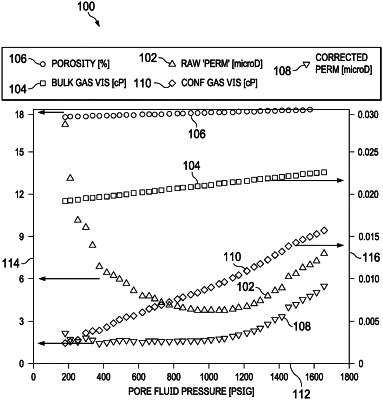| CPC G01V 20/00 (2024.01) [G01N 11/00 (2013.01); G01N 15/088 (2013.01); G06F 30/20 (2020.01); G06F 2111/10 (2020.01); G06F 2113/08 (2020.01)] | 17 Claims |

|
1. A method for integrating slip flow and Knudsen diffusion (SFKD) into a reservoir simulation of a reservoir, the method comprising:
obtaining a rock sample, the rock sample being representative of rocks located at the reservoir;
adjusting, the rock sample to a set of different pressures;
applying, to the rock sample at each of the different pressures of the set, gases using single-component and bulk-phase gas viscosity values;
measuring, at each of the different pressures of the set, respective permeability values of the rock sample, the permeability values being a function of the single-component and the bulk-phase gas viscosity values;
performing, based on the measuring, SFKD adjustments to each gas component value of a reservoir gas, the adjustments representing composite SFKD effects for realistic gas mixtures for the reservoir gas;
determining for each adjusted gas component of the reservoir gas, porosities including mean free paths for a range of temperatures and pressures encompassing conditions for both reservoir simulation input and the measured permeability values;
determining a characteristic pore radius for the rock sample using the measured permeability values and the determined porosities;
determining using the measured permeability values, viscosity adjustment factors for a predefined range of temperatures and pressures;
determining using the viscosity adjustment factors, adjusted gas viscosities for the realistic gas mixtures for the reservoir gas, the gas viscosities being adjusted for the predefined range of temperatures and pressures and the measured permeability values;
executing, by a reservoir simulator, the reservoir simulation using the adjusted gas viscosities, the reservoir simulation having an increased accuracy relative to a reservoir simulation that does not capture SFKD effects;
based on executing the reservoir simulator, generating a prediction for an amount of production from one or more existing fractured wells at the reservoir;
based on the prediction, selecting one or more locations in the reservoir; and
updating production operations at the reservoir by performing hydraulic fracturing at the one or more locations.
|